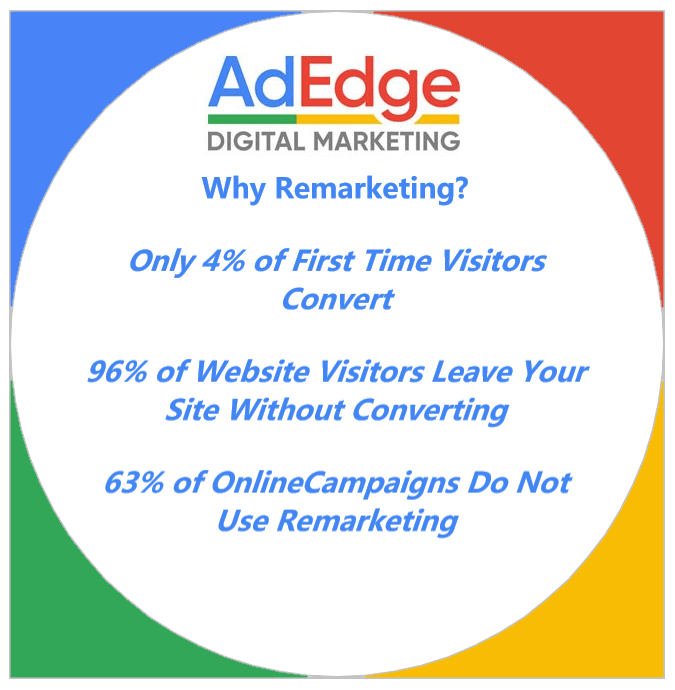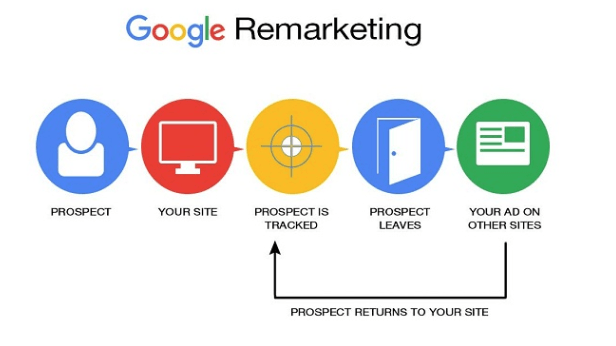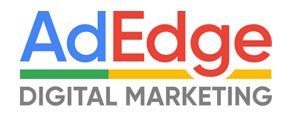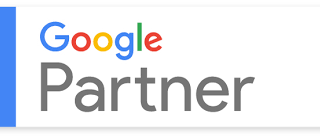What is Re-marketing?
Re-marketing, also known as re-targeting, is defined as a type of online advertising that shows ads to people who have visited your website, or a specific web page, and may have exhibited a specific behavior (e.g., not converting into a site conversion goal). For example, let’s say you were browsing on Amazon but didn’t make a purchase. When you go to another website, you will see an ad for that product from Amazon. Re-marketing, using Google Ads and Facebook, is a great way to reach previous website visitors and make your digital marketing more successful. It is a second chance to advertise, an opportunity to cross-sell, up-sell or nurture your audience with your content marketing efforts. Rather than having to rely on targeting customers that have filled out a form for an e-book, call, blog, or newsletter, you can re-target ones that have interacted with your site. You can engage with visitors even when they leave your website and work to convert them at their own pace.

Why Re-marketing?
Studies show that, 96 percent of visitors that land on your website will not convert into a sale or new customer. No matter how attractive or creative your ads, getting a first time conversion is unlikely, happening about 4% of the time on average. Currently, most clients do not use re-marketing and approximately 63% digital marketing campaigns on Google and Facebook do not use re-marketing tactics. This is a big opportunity to businesses to reach the 96% interested viewers who did not yet convert. When browsing the web from a desktop or a smartphone, it is easy to get distracted. So re-marketing is a great way to keep your brand front and center in the minds of your customers and potential customers. It has been proven that returning visitors have a higher chance of converting. This is because returning visitors recognize your brand and, with each subsequent interaction, their recall increases.
Types of Re-marketing?
Google began re-marketing offering for display advertising in 2010, with Google Search following in 2013. Google’s Display Network works with some of the most highly trafficked sites at a much more affordable price than working directly with the site. Through Google Ads, you can re-target visitors with ads that show the products they viewed on your website. For the search network you can also use something called re-marketing lists for search ads (RLSA). Basically, you can reach people searching for specific keyword terms who have previously visited your site.
Social media
Facebook launched custom audiences in 2012, its version of re-marketing. In re-targeting ads on Facebook, not only are you seeing a special offer with a clear call-to-action (CTA) – you also see how many of your friends “like” the fan page.. This is often called the herd or pack mentality – when people mimic the behaviors of those around them. This adds credibility to your brand, which can help boost conversion rates for people who are on the fence. The average click-through rate (CTR) for Facebook display ads is 0.07% when the CTR for re-marketing ads is 0.7% – 10 times higher. Studies show that people are 70% more likely to convert with a re-marketing campaign than with an initial campaign.
Using your current email list, it’s possible to show ads specifically to people on your email list. The email mailing lists can be uploaded directly to Facebook and Google. But you can also use re-marketing to create audiences using email addresses you’ve collected from your current customers or through lead generation. Also, anyone who opens your email can be served a follow-up advertisement related to the email.
How it works?
The most common type of re-targeting is known as pixel-based re-targeting. This works by placing a piece of JavaScript on the browsers of visitors to your website. This pixel is a snippet of code that will be able to track users for the campaign to serve ads when the time is right. After they leave your site and continue to surf the web, they will be served ads based on what they viewed on your website. In some cases, initially you may find that re-marketing volume is actually small. Keep in mind as time goes on you can build up a larger list with historical data. The typical 30-day window to build an audience could be too small to reach an audience. It’s possible to go up to 180 days from the last time a user visited the website. The minimum list size in Google Ads is 1,000 users, based on your typical CTR (click rate) and CVR (cost per view) you may need a higher threshold. For example, if you typically see a 5 percent CTR and a 2 percent CVR, 1,000 impressions will produce up to 50 clicks with the minimum list size.
What should my message be for re-marketing ads?
A common assumption is that someone who did not convert may need an extra incentive in the form of repeated and/or more compelling messaging. Many users in their discovery phase are not only researching potential solutions but also confirming that the problem they are looking to solve is indeed the right problem to be solving. When setting up re-marketing, test both a sell message and a cross-sell or up-sell message. Give users more reasons to keep you in mind, particularly if your site offers products that are common supplements or complements. The sell message entails saying the same thing users heard before in a different way: with a more direct call to action and/or an exclusive, one-time offer. It is important to note that you must notify all visitors to your site that you will be using cookies, i.e., the Facebook pixel, to track them for advertising purposes. This is typically done on a privacy policy page.
Conclusion
Re-targeting can seem overwhelming or confusing at first, especially with all these terms, platforms and information overload. In simple terms, It’s just like trying to bring window shoppers into a physical store. , It is the digital version of selling to a customer after you’ve already met and had a conversation with them. To learn more about re-marketing and how it can help your business you can contact us at 203-682-4585 or sign up for our our newsletter to receive monthly updates about the latest digital marketing tactics.



